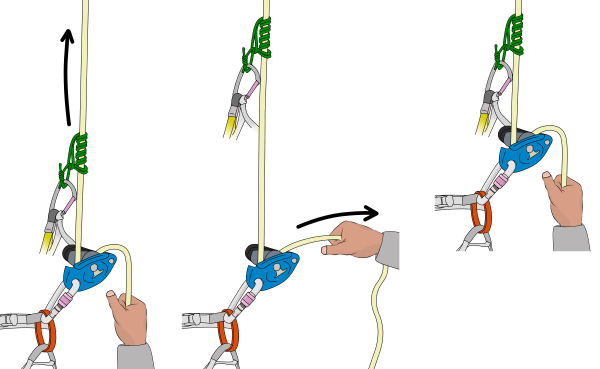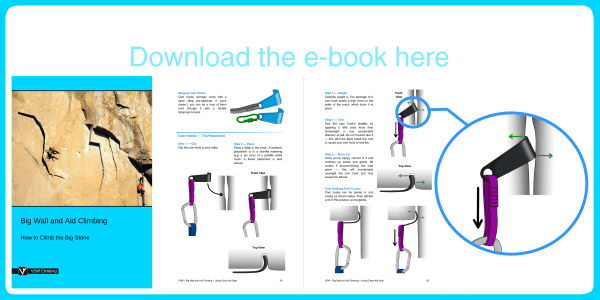Check out the full big wall video course, or download the e-book.
When to Fix Pitches on a Big Wall
It is common to fix ropes on a big wall. Often this is because you’ve climbed the first few pitches and want to have a final night of luxury on the ground before committing to the wall. This also means less food and water is needed on the route.
Fixing isn’t always the best strategy. If you fix a few pitches of overhanging rock, you’ll have to jumar a seemingly endless free-hanging rope which will probably be more effort than just taking the extra water and staying on the wall. Figure this out before you begin.
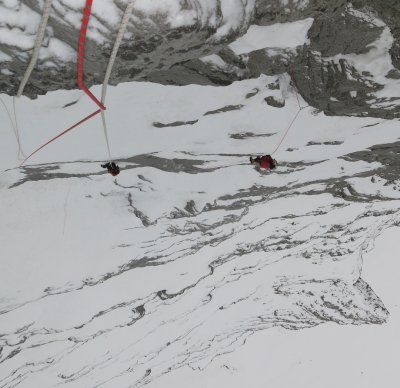
You will fix ropes during the climb too if going capsule-style, or maybe you have time in the evening to lead a pitch, but not clean or haul it. You can leave it fixed and return to your portaledge for the night. Simply fix both ropes and abseil down the haul line. In the morning, jumar up the haul line and continue as normal. Ropes can also be fixed to avoid hauling over difficult/traversing terrain. For example, it may be better to fix a few wandering pitches and then do one long haul in a straight line, rather than two or three shorter more problematic ones.
Protecting the Rope
It is crucial that ropes are protected from sharp edges when left fixed. This can be achieved in a variety of ways:
- Stick duck-tape over sharp edges. Remove it when you’re finished.
- Place directionals to re-route the rope away from cracks and edges.
- Wrap a rope-protector around the rope at high friction zones.
- Use re-belays.
- Use good technique. Abseil and jumar smoothly to prevent the rope from sawing across the rock. Never bounce on the rope.
Re-Belays
Jumaring a long line of fixed rope which stretches out of sight above can be unnerving and dangerous. If you can’t see the full length of rope to the next anchor, you can’t be certain that the rope isn’t caught behind a flake or loose block somewhere.
70 meters of dynamic rope stretches a lot when jumarred on, which increases the amount that it rubs against potential sharp edges. This danger can be reduced by adding re-belays where needed.
Tie the rope to a few appropriate pieces on your way down, creating mini-belays. When done correctly, this prevents the rope from coming tight over potential danger areas and also means you don’t have to wait as long for your partner to finish jumaring before you can start up.
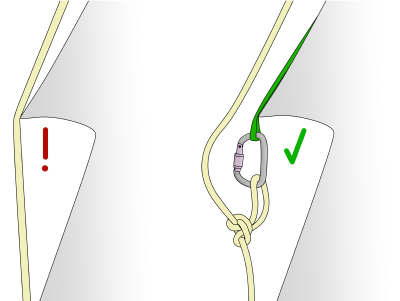
Belay Points
When attaching ropes to belays, try to use the ends of the ropes so you don’t have to pass knots mid pitch (this probably won’t be possible if you’re stretching your ropes up the wall). At belays, make sure to tie excess rope away so there is no confusion about which rope to attach to next. Accidents have happened when climbers have abseiled off the end of a short tail of rope, mistaking it for the fixed line. Tie the ends of all ropes into the anchor so this cannot happen.
Rope Tension
The ropes will need to be slack enough allow a climber to tie a knot (e.g: a back-up knot when passing re-belays or if isolating a damaged section) and to jumar and abseil on. But don’t make them so slack that they blow around in the wind and get stuck behind flakes. If your rope is wet, allow extra slack because ropes shrink as they dry. On the ground, attach your rope to a solid anchor out from the base of the wall to keep it away from the rock and stop it blowing up onto the wall.
Joining Ropes
Ropes can be connected together with a variety of knots. The one shown here offers a handy clip-in point so you don’t need to tie an additional back-up knot when passing through. Start by tying two overhand knots, then isolate them inside an alpine butterfly.
If you tie your ropes together with standard overhand knots, make sure to add a back-up knot of some kind when jumaring or abseiling past the knot.
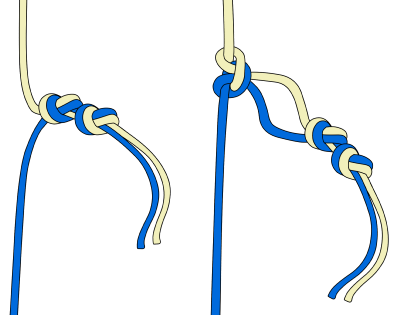
Abseiling Past a Knot on Fixed Ropes
Step 1
Stop abseiling just before the knot and clip into the back-up point.
Step 2
Attach a jumar to the rope above you and weight it.
Step 3
Remove your belay device and re-attach it below the knot. If you can’t reach, attach your other jumar and ‘reverse ascend’ one move so you are weighting your belay device.
Step 4
Check the system, then remove your jumars and back-up point.
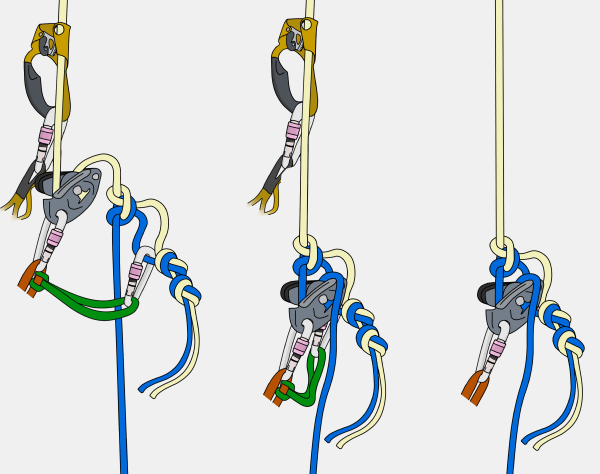
Ascending Fixed Ropes
Technique
Ascend fixed ropes as normal using two jumars and a GriGri. For added security, clip carabiners through the top holes in your jumars so they can’t pop off the rope. The tension of the rope from below should auto-feed your GriGri. Move smoothly to reduce the amount that the rope rubs across the rock. Always check each rope before you commit your life to it.
Don’t jumar up a rope which is stuck behind a flake or appears to be damaged. If you don’t trust the fixed rope, you can re-lead the pitch.
Alternatively, jumar the rope while being belayed on another rope, placing gear as you ascend in case the rope snaps.
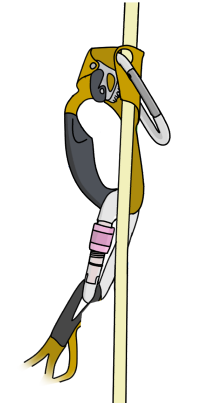
Passing Belays
Always add a back-up when passing knots, anchors or re-belays. A simple method is to clovehitch the rope to your belay loop.
At the anchor, take the stretch out of the next rope by using your jumars to pull the rope tight. Then unclip from the anchor and continue up.
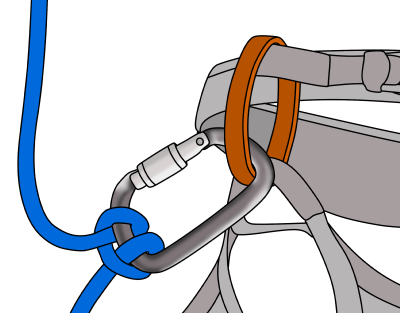
Fixing Mid-Pitch
If you can’t complete a pitch (e.g: because of darkness, fear or bad weather), you may choose to lower down and finish it off later. If you’re less than half a rope length up a pitch, you can simply lower down from your top pieces to the belay. However, this method puts twice as much weight on your lower-off point (the weight of you and your partner) and pulls all your gear at a weird angle when the rope is tensioned. For these reasons it’s better to use the following method. Also, if you’re more than half a rope length up, you’ll have to use this method.
Step 1
Equalize the top few pieces to make a good lower-off point.
Step 2
Clip the end of the haul rope to this point with two screwgates.
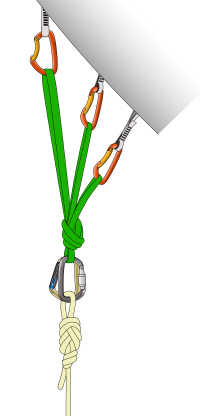
Step 3
Attach the lead rope to the screwgates with an alpine butterfly knot.
Step 4
Attach your GriGri to the haul rope and get ready to abseil.
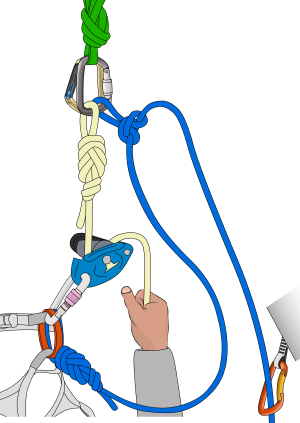
Step 5
Check the system. Then untie from the lead rope and abseil down. Your partner keeps you on belay until you’re back at the anchor and safely tied in. If the lower-off point fails, you’ll fall and be backed up by the protection you placed during the pitch. Falling mid-abseil like this isn’t ideal, so make sure your lower-off point is good.
Step 6
If leaving the ropes overnight, tie them to the belay under a bit of tension to keep them in position.
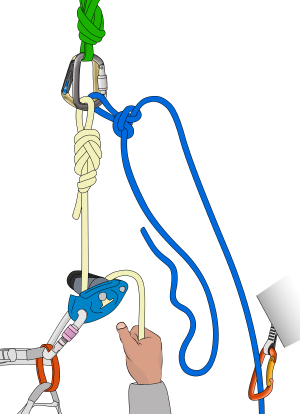
Fixing Mid-Pitch - Ascending To Your High Point
Step 1
Get put on belay in the same spot on the rope that you were previously taken off belay.
Step 2
Ascend to your high point using a klemheist prusik and a GriGri. This way, if your lower-off point fails, you will shock-load your GriGri and prusik, not the sharp teeth of your jumars. Use your jumars to ascend only if you’re certain the lower-off point is bomber.
Step 3
Tie back into the lead rope, clip the haul rope away on the back of your harness and continue climbing, leaving the equalized gear as a bomber piece.
